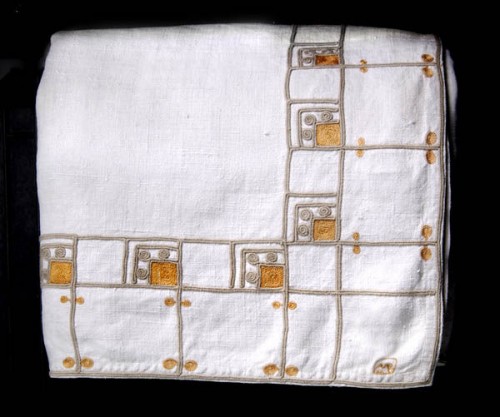One woman in particular that influenced modernism works was Vanessa Bell, who held workshops that were home to many other artists gearing towards modernist art, where they decorated many pieces of pottery and tapestries (Chadwick 256-257). Bell incorporated modernism into textiles, using wool and linen to make pieces that resembled nature. This was not uncommon, as other influential women modernist artists used nature to depict their art as well, such as Margaretha von Brauchitisch and Eva Hesse (Chadwick 252).
 In this painting by Bell, the use of abstraction and shapes is evident. The shapes and color placement make the image bold and freestanding. The shapes are not grounded, nor are they exact--but they are detectable. The blocks of bold, colorful shapes help give the painting an abstract feel. Abstract Painting, 1914 by Vanessa Bell
In this painting by Bell, the use of abstraction and shapes is evident. The shapes and color placement make the image bold and freestanding. The shapes are not grounded, nor are they exact--but they are detectable. The blocks of bold, colorful shapes help give the painting an abstract feel. Abstract Painting, 1914 by Vanessa Bell In the painting by Eva Hesse, another form of abstraction in modernism, two figures are shown. They are not quite human nor quite animal, but more of an abstract being without any definitive form. The use of oil paintings were common in her work, and while this painting is abstract, it is also considered a minimalist painting. There is little use of vibrant colors or scenes, but the painting can stand alone. The colors pop but the coloring itself is generally light. Eva Hesse, Untitled
In the painting by Eva Hesse, another form of abstraction in modernism, two figures are shown. They are not quite human nor quite animal, but more of an abstract being without any definitive form. The use of oil paintings were common in her work, and while this painting is abstract, it is also considered a minimalist painting. There is little use of vibrant colors or scenes, but the painting can stand alone. The colors pop but the coloring itself is generally light. Eva Hesse, UntitledBoth of these painting illuminate two important concepts--the change in art form, and the artists behind it. These women, generally not entitled to entrance into the artistic world, changed the function and liberation of art. These abstract, unorthodox paintings were powerful statements--but the fact that women were behind many of the great, game-changing pieces, is even more important.
 This important work by Margarete von Brauchitsch is an example of embroidery, a growing method of art in modernism. The simplistic, yet detailed design is easy on the eyes, while incorporating the similar geometric shape sequence that we have seen in other paintings of the time. Tafeltuch, 1910
This important work by Margarete von Brauchitsch is an example of embroidery, a growing method of art in modernism. The simplistic, yet detailed design is easy on the eyes, while incorporating the similar geometric shape sequence that we have seen in other paintings of the time. Tafeltuch, 1910Much of the influence of modernism revolved around forms of German expressionism, or versions of it. Paula Modersohn-Becker was a female voice of Modernism, specifically expressionism.
 Die Malerin mit Kamelienzweig, 1907 Her work here exemplifies certain key points, including aforementioned concepts of nature. This is also a self portrait, expressing qualities of the author herself through the paintings. This idea of self-portraits was not new, but the method in which it was drawn, including details around the eyes and the seeming animation behind the drawing, was.
Die Malerin mit Kamelienzweig, 1907 Her work here exemplifies certain key points, including aforementioned concepts of nature. This is also a self portrait, expressing qualities of the author herself through the paintings. This idea of self-portraits was not new, but the method in which it was drawn, including details around the eyes and the seeming animation behind the drawing, was.Modernism has expanded and was a combination of a multitude of other expressive art forms, including dadaism and expressionism. Women artists behind this were proof of the incorporation of liberation into art. By combining timeless facets of art into what is now the latest form of art, and possibly the last, modernism was formed.
-Ray
No comments:
Post a Comment